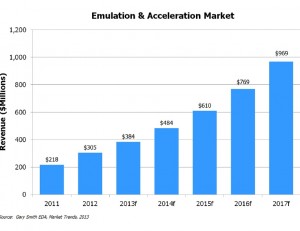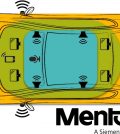Move to Datacenter Pushes Emulation Market to New Heights

The trend in emulation is to include the emulator in a datacenter or enterprise computing environment. Mentor has led the way on this for a while, starting with the announcement two years ago of its VirtuaLAB software, probably the first step to moving emulation to the data center. Looking forward, Veloce is improving on the concept, promising to consolidate various emulation resources into one global entity.

Gary Smith EDA shows a continuum of actual (2011- 2012) and estimated (2013-2017) hardware emulation growth
Benefits of this consolidation include offering things like PSL/SystemVerilog assertions, functional coverage, and UPF for low power. The virtualization of the emulation environment addresses the explosive grow of performance needs for verification.
The emulation business will grow significantly as these data centers are set up and used by very large companies or shared by multiple companies, or even accessed on a virtual basis in a pay for time scenario. Instead of the traditional image of emulation as a big box with limited users, we will see server farms and billion-dollar plus levels of business.
Gary Smith EDA, the leading provider of market intelligence and advisory services for global Electronic Design Automation (EDA) and Electronic System Level (ESL) design, agrees. He forecasts hardware emulation growth of about 25% a year until 2017, anticipating a total market size of nearly $1 billion by 2017, as illustrated in the following chart:
By going forward in this fashion, there seems to be no limit to the transition to emulation in the industry. We expect revenue to grow at a healthy rate in the upcoming fiscal 2015. And we expect the number of companies wanting to adopt emulation will continue to increase because it’s driven by the complexity of chips, and chip complexity always increases.
Furthermore, we are seeing major orders from people we’ve never done business with before. System companies are adopting and becoming a bigger percentage of the emulation market. These aren’t the traditional customers for IC design, and yet they have now become emulation users. As far as the existing emulation users, there seems to be no limit to their appetite for more emulation. Once they do a chip with emulation, the engineers become dependent upon it, and they want more of the kind of verification only emulation has the speed and capacity to provide.
All of these forces are moving emulation into the mainstream of system-level design where it will soon come to be seen as an indispensable tool for a large pool of users.
In the picture: Gabiele Pulini, product marketing manager in the Mentor Graphics Emulation Division
Gabriele Pulini
Contenuti correlati
-
Partnership tra Altair e Samsung Electronics
Altair ha annunciato di essere stata scelta come partner per l’automazione della progettazione elettronica (EDA) per il Samsung Advanced Foundry Ecosystem (SAFE). Questa collaborazione permetterà di combinare la tecnologia EDA di Altair, compresi gli strumenti per il...
-
Certificazione ISO 26262 per l’ambiente di progettazione FPGA di GOWIN
GOWIN Semiconductor ha annunciato che il suo ambiente di progettazione FPGA GOWIN EDA è stato certificato conforme agli standard di sicurezza funzionale ISO 26262 e IEC 61508 dal laboratorio di test TUV. La certificazione del design tool...
-
La nuova soluzione Veloce CS di Siemens per migliorare l’emulazione e la prototipazione
Siemens Digital Industries Software ha presentato Veloce CS, un sistema di verifica e di validazione hardware-assisted che integra all’interno di un unico sistema l’emulazione hardware, la prototipazione di livello enterprise e la prototipazione software. Questa soluzione rappresenta...
-
Synopsys acquisisce Ansys
Synopsys e Ansys hanno annunciato di aver siglato un accordo definitivo in base al quale Synopsys acquisirà Ansys. Le aziende sottolineano che la combinazione della tecnologia EDA di Synopsys con le capacità di simulazione e analisi di...
-
La tecnologia di simulazione di Siemens EDA scelta da RS Group
Siemens Digital Industries Software ha annunciato che RS Group ha scelto Siemens come fornitore strategico di automazione della progettazione elettronica (EDA) per il suo nuovo strumento DesignSpark Circuit Simulator, cloud nativo, che consente agli utenti di ottimizzare...
-
Prospettive di mercato per il 2023: quattro macro-tendenze da monitorare nella progettazione degli IC
Di Joe Sawicki, Executive Vice President of IC EDA – SIEMENS Nonostante le incertezze legate all’attuale contesto economico e geopolitico, il 2022 è stato un anno stellare per l’innovazione in campo elettronico, e sono sicuro che nel...
-
VCO2S di Mentor riduce i costi dei sistemi di cruscotti digitali nell’automotive
Mentor lancia VCO2S (Vehicle Cockpit Consolidation Solutions), soluzione innovativa rivolta agli OEM del settore automotive ed ai loro fornitori e dedicata alla progettazione ed allo sviluppo di sistemi per cruscotti integrati di nuova generazione, controllati da una...
-
RECOM collabora con SAMACSYS per i modelli EDA
RECOM ha annunciato una partnership con SAMACSYS, una società di Supplyframe, per fornire modelli digitali di prodotti RECOM. Simboli, footprint e modelli CAD 3D sono disponibili gratuitamente in un gran numero di formati, compresi STEP e VRML,...
-
Mentor collabora con Arm per ottimizzare la verifica funzionale degli IC
Mentor ha annunciato una partnership con Arm per aiutare i progettisti di circuiti integrati a ottimizzare e semplificare la verifica funzionale dei loro progetti basati su Arm. Con questa collaborazione, il programma Arm Design Reviews offre ora...
-
Linux e la sicurezza nello sviluppo di apparecchiature medicali
Questo articolo si focalizza sull’utilizzo di Linux per lo sviluppo di applicazioni embedded e sulle misure di sicurezza necessarie per il suo impiego nelle odierne apparecchiature medicali. Leggi l’articolo completo su EO Medical 20



















